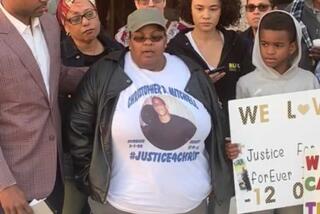Texas trooper won’t be indicted in border helicopter shooting deaths
- Share via
HOUSTON — A grand jury has declined to indict a Texas trooper who fired from a helicopter at a fleeing pickup near the Mexican border last year, killing two Guatemalan immigrants and sparking controversy.
The killings led the Texas Department of Public Safety to bar troopers from shooting at suspects from the sky unless their aircraft is fired upon.
The grand jury heard testimony from witnesses and considered evidence, including a video of the incident taken from the helicopter, according to Rene Guerra, the Hidalgo County district attorney.
“Once you see the video, everybody is able to judge for themselves. There’s nothing hidden in the shooting — you can observe the chase from the helicopter. It is what it is,” Guerra said.
He said it was clear the trooper was aiming his .308 rifle at the truck’s rear tires.
The district attorney declined to say who testified before the grand jury, citing confidentiality, but said he was “very satisfied” with the Texas Rangers’ investigation, conducted in collaboration with his office.
After the grand jury announcement, Texas Department of Public Safety officials released a statement noting that they “appreciate the time, effort and professionalism from all involved throughout this case.”
“It’s tragic that someone lost their life. The fact is that a trooper was doing his job as he was trained to do. The grand jury supported the fact that we in law enforcement can continue doing our job as long as we’re doing it for the right reasons,” said Texas Highway Patrol Sgt. Gary Chandler, president of the Department of Public Safety Officers Assn., which has about 3,000 members, including the trooper involved in the helicopter shooting.
The trooper was initially placed on administrative leave, but has since been permitted to return to work. The two pilots involved remained on active duty.
The incident began on the afternoon of Oct. 25, when a Texas Parks and Wildlife Department game warden tried to pull over a red pickup near La Joya, about 250 miles south of San Antonio. The pickup sped off, the warden gave chase and requested help, and a Texas Department of Public Safety helicopter joined midway into the high-speed pursuit down a dusty gravel road.
The trooper who opened fire from the helicopter believed the truck was being used to smuggle drugs, its bed covered with a tarp, and he was trying to stop the driver as he sped toward a school zone, authorities said. Instead of drugs, officers who responded to the scene found 10 immigrants, most of whom had been hiding under the blanket, including the two killed.
The dead, Jose Leonardo Coj Cumar, 32, and Marcos Antonio Castro Estrada, 29, had crossed illegally from Mexico. Castro left behind two daughters and a wife who was three months pregnant, while Coj, a father of three, came to the U.S. to pay for arm surgery for his 11-year-old son, Guatemalan officials said.
The immigrants, field workers, had traveled for 19 days from their rural hometown of San Martin Jilotepeque and paid $5,000 to be smuggled across the U.S. border to stay with relatives in Houston, New Jersey and New York.
The young driver fled the scene but was later arrested, officials said.
Civil rights groups and the Guatemalan government called for an independent investigation, as did the Texas Department of Public Safety, leading to a review by the FBI and the U.S. Department of Justice’s Civil Rights Division.
The FBI referred questions Wednesday to the Justice Department, whose spokeswoman said it was still “reviewing the facts to determine whether federal action is appropriate.”
Texas safety officials initially defended the shooting, saying the trooper followed the policy at the time, which allowed officers in helicopters, in cars or on foot to fire on vehicles during pursuits to apprehend suspects, disable vehicles or defend themselves or others.
The policy set Texas apart from other states. In California, for instance, Highway Patrol policy allows troopers to shoot at vehicles only to stop a threat, not to disable a car. CHP officers can’t shoot from a helicopter, a spokeswoman said.
According to the new Texas policy, “a firearms discharge from an aircraft is authorized only when an officer reasonably believes that the suspect has used or is about to use deadly force by use of a deadly weapon against the air crew, ground officers or innocent third parties.”
Under the new policy, “a suspect’s driving behavior including aggressive or reckless driving to evade arrest does not constitute use of a deadly weapon by the suspect.”
Some who protested after the shooting said they were not surprised that the grand jury declined to indict the officers involved.
Terri Burke, executive director of the American Civil Liberties Union of Texas, helped organize a protest of about 35 people at the site of the shooting about a week afterward. She said her group reached out to the immigrants involved, but never heard back.
Burke was curious about the investigation that led to the grand jury’s findings in the case, the latest in what she described as a series of abuses by state and local law enforcement along the border.
“There’s a long history — these folks skate,” Burke said. “We [will] never know what went on in that investigation except that they’ve been absolved.”
Burke said her group lobbied state legislators to hold a hearing and force the policy change concerning helicopter shootings. The Texas ACLU plans to keep an eye out for incidents involving troopers along the border.
“We’re monitoring every time they do something down there — I want to be certain that policy is followed,” she said.
molly.hennessy-fiske@latimes.com
More to Read
Sign up for Essential California
The most important California stories and recommendations in your inbox every morning.
You may occasionally receive promotional content from the Los Angeles Times.











